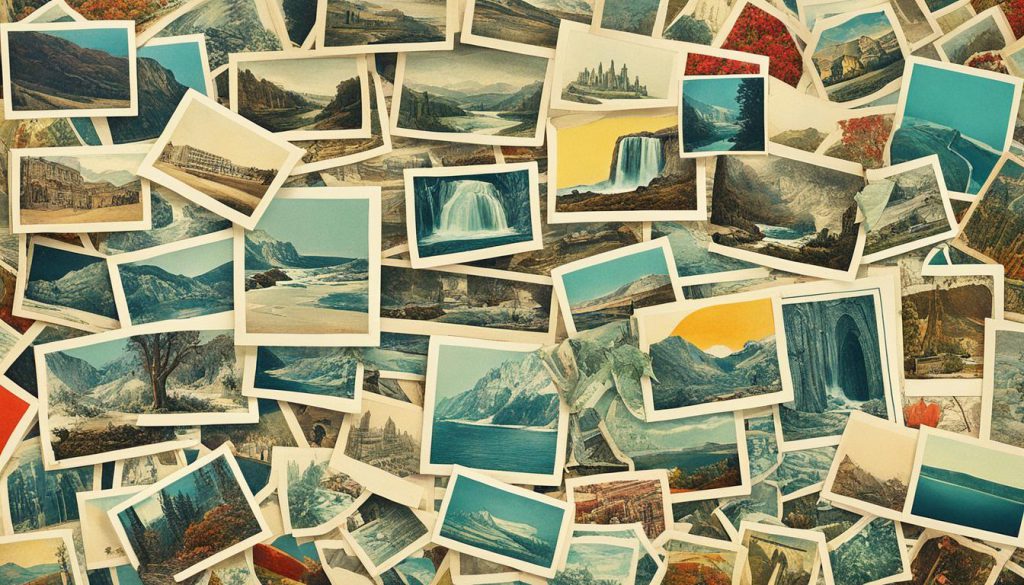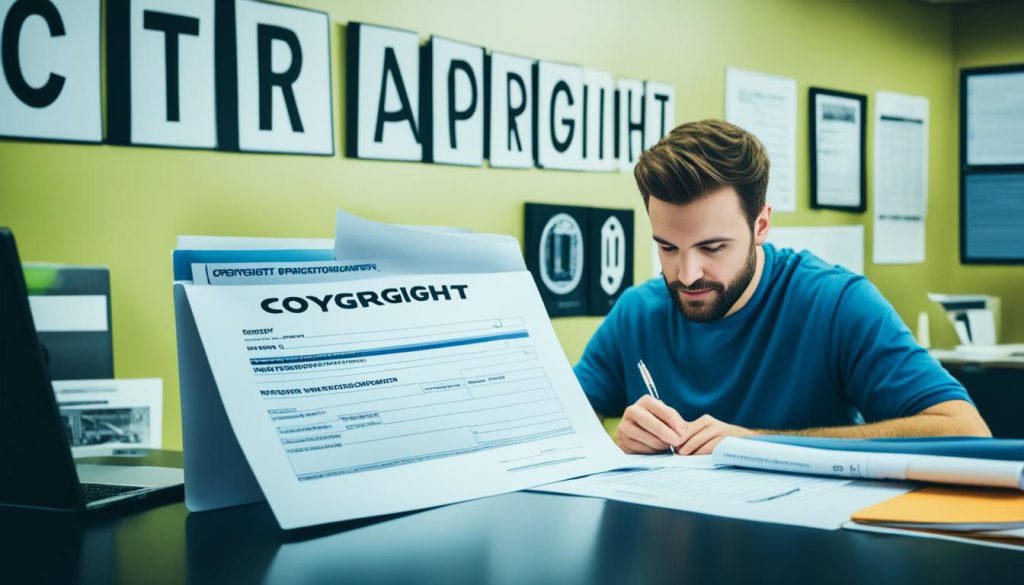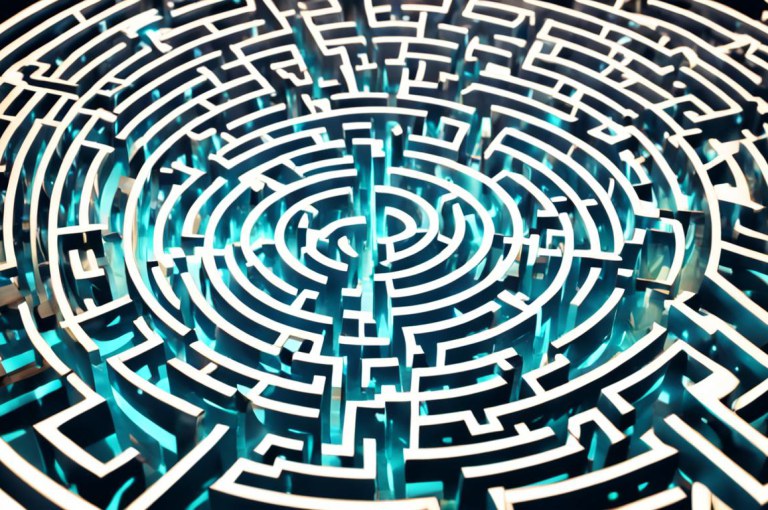Ever wondered how to protect your creative work? Do you know what can be copyrighted? It’s important for creators and users to understand copyright and intellectual property rights. This guide will help you grasp the essentials of copyright law. It will also show you how to register your work, guiding you through copyright laws.
Key Takeaways:
- Understanding copyright laws is essential for safeguarding your creative works.
- Copyright grants creators exclusive rights over their works.
- Registering your copyright provides added benefits and protection.
- Works in the public domain are not protected by copyright.
- Copyright infringement can have serious consequences.
What is Copyright?
Copyright is key in the realm of creative works. It shields the rights of those who create. Knowing what copyright means is vital for both creators and users of such materials.
Copyright gives the creator ownership over their new work. This right allows you to make copies, change, share, perform, and show off your work. It’s a way to keep your hard work safe.
The length of copyright protection changes based on different things. Over time, laws have changed, making copyright last longer. In the U.S., it lasts a creator’s life plus 70 more years. But this can vary for various works or those made by companies.
Some works don’t get copyright protection. If a work is in the public domain, anyone can use it freely. These are usually old works whose copyright ended, or ones that never could be copyrighted.
History of Copyright Law
Copyright laws in the U.S. have changed a lot to protect creators’ rights. These laws keep intellectual property safe and encourage creativity in arts and writing.
The U.S. Constitution lets Congress make copyright laws. The first law came in 1790, starting a system to protect original works.
Since then, copyright laws have been updated many times. This is to keep up with new technology and the internet. These updates are meant to tackle new issues.
Two important laws have shaped copyright rules today. They are the Sonny Bono Copyright Term Extension Act and the Digital Millennium Copyright Act (DMCA).
The Sonny Bono Act was made in 1998. It made copyright last longer for works made after 1922. Now, copyright lasts for the creator’s life plus 70 years. This helps creators and their families protect their works for longer.
The DMCA, also from 1998, deals with digital technology and the internet. It protects copyright owners. It also helps handle copyright issues online.
These changes and acts show efforts to keep copyrights fair in the digital world. They help ensure copyright protection stays strong in the U.S.
Copyrightable Works: What Qualifies?
Copyright protection covers many works. These include literary, musical, dramatic, artistic, and audiovisual creations. They are protected under copyright law.
A work must be original to be protected. This means:
- Originality: It should come from the author’s own creativity. It shouldn’t be copied from others. Even if the creativity level needed is low, there must still be some creativity.
- Fixation: The work must be recorded in a way that can be seen or touched. This means it could be on paper, a disc, or a digital file. Ideas alone, without physical form, are not protected.
However, not all content is protected. Things like ideas, facts, or slogans are public domain. They don’t get copyright protection.
“The expression of ideas is what copyright protects, not the ideas themselves.”
Take a novel’s unique expression as an example. The author can protect how they write about their characters and plot. But they can’t protect the basic idea of a detective story.
Let’s dive into the different types of copyrightable works:
Literary Works
Literary works include things like novels, poems, and articles. It covers both stories and informative writing.
Musical Works
This refers to melodies, songs, and compositions. They can be written down or recorded.
Dramatic Works
These are plays and movie scripts. It’s about performances, whether live or recorded.
Artistic Works
This category has art like paintings, sculptures, and photos. These can be physical or digital.
Audiovisual Works
Audiovisual works mix visual and sound. This includes movies, TV shows, and documentaries.
Here’s a visual representation of the types of copyrightable works:
| Type of Work | Examples |
|---|---|
| Literary | Novels, poems, articles |
| Musical | Songs, compositions |
| Dramatic | Plays, film scripts |
| Artistic | Paintings, sculptures, photographs |
| Audiovisual | Movies, TV shows |

It’s key to know which works are protected and about originality. This helps creators protect their work and control their intellectual property.
Non-Copyrightable Materials
Copyright helps protect creative work. However, not everything can be copyrighted. Some things, like basic facts or public info, can’t be.
Things like titles, slogans, or colors aren’t copyrighted. They’re too simple or basic. So, similar book or movie titles can be used by anyone.
Copyright law protects how ideas are shown, not the ideas themselves. It’s about how these ideas are put into something real. This is key because it means ideas can be shared freely.
Some works are not protected because they belong to everyone. These are works in the public domain. Their copyright might have expired. This lets people freely use and share these works.
Understanding what can’t be copyrighted is key. It helps navigate copyright law. It makes sure works are protected or shared the right way.

[Image Description: The image shows a stack of open books, symbolizing public domain works.]
How to Register a Copyright
Copyright protection starts when you create something. But, registering with the U.S. Copyright Office has benefits. It makes your copyright public and helps prove it’s valid. This is very important for works from the U.S. and when taking copyright cases to court.

- Complete the application form: Fill out the necessary details on the U.S. Copyright Office’s online system or on paper.
- Provide a copy of the work: Submit a copy of your work in physical or digital form as needed.
- Pay the registration fee: You need to pay a fee, which can be done online or by mail.
- Submit the application: After preparing the application, work, and fee, send them to the U.S. Copyright Office.
- Wait for processing: The Copyright Office reviews your application and might ask for more information.
- Receive the certificate: If approved, you’ll get a certificate of registration, marking your copyright.
Registering gives you extra benefits and protections. Some top advantages include:
- Legal evidence: It provides a public record of your copyright, proving ownership and validity.
- Court enforcement: You must register to sue for copyright infringement, allowing legal action and possible damages.
- Statutory damages and attorney’s fees: With registration, you can claim damages and lawyer’s fees in infringement cases.
- International protection: It helps in getting copyright protection abroad through international agreements.
Disclaimer: This info is for general understanding and not legal advice. For specific advice, consult a lawyer or visit the U.S. Copyright Office’s website.
Copyright Infringement: What Counts?
Copyright infringement happens when copyrighted work is used without the owner’s permission. This includes copying, sharing, performing, or showing the work illegally. It’s vital to get permission from creators before using their work.
The effects of copyright infringement can be serious. Owners have the power to sue, leading to court and possibly high fines. In some situations, copyright breaches can cause huge money losses.
But there’s an exception called fair use. It lets people use copyrighted work for things like reviews, news, teaching, or research without needing permission. Judging fair use depends on various factors, like the use’s purpose and impact.
“Fair use is key in copyright law. It protects creators’ rights while allowing freedom and innovation. It lets us use copyrighted materials in beneficial ways, respecting the original creators.”
The Digital Millennium Copyright Act (DMCA) helps owners deal with online copyright violations. Through the DMCA, owners can ask platforms to remove infringing content. The platforms must act quickly to not be held liable. This process helps protect creators’ rights online.
Understanding copyright rules, fair use, and the DMCA is crucial. These steps help ensure your use of copyrighted materials is legal. And it shows respect for creators’ rights.
Conclusion
Understanding copyright laws is crucial for creators and users alike. Learning the basics helps us protect our own work. It also lets us respect others’ rights. Copyright gives creators control over their works. This includes how they are used and shared.
Respecting copyright laws boosts creativity and innovation. It makes sure creators can keep creating, knowing their work is safe. It also means creators get fair pay for their work. This helps them keep making things that improve our world.
Whether you’re an artist, writer, or musician, knowing about copyright is key. It protects what you create. For those who use creative works, it’s also important. It lets us enjoy and benefit from others’ work without breaking the rules. Let’s all support copyright protection. It’s vital for our creative future.




Thank you for your sharing. I am worried that I lack creative ideas. It is your article that makes me full of hope. Thank you. But, I have a question, can you help me?
Thank you for your sharing. I am worried that I lack creative ideas. It is your article that makes me full of hope. Thank you. But, I have a question, can you help me?
I don’t think the title of your article matches the content lol. Just kidding, mainly because I had some doubts after reading the article.
Thank you for your sharing. I am worried that I lack creative ideas. It is your article that makes me full of hope. Thank you. But, I have a question, can you help me?
Can you be more specific about the content of your article? After reading it, I still have some doubts. Hope you can help me.
I don’t think the title of your article matches the content lol. Just kidding, mainly because I had some doubts after reading the article.
child porn
child porn
child porn